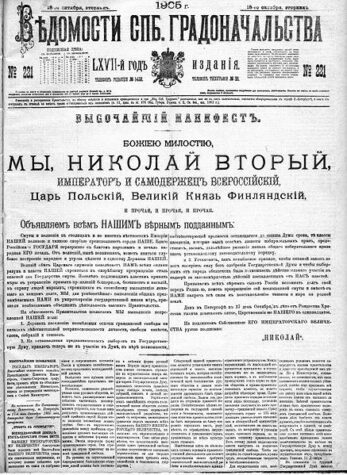
The October Manifesto was a document promising political reforms, issued by Tsar Nicholas II at the height of the 1905 Revolution. It came after ten months of popular unrest, strikes, violence and political debate about the future of Russia. The manifesto promised the formation of a State Duma: a national parliament, elected by the people of Russia, to participate in the formulation and passing of laws. It also outlined improvements to individual rights and freedoms. The October Manifesto was met with approval by most reformists, particularly liberals and moderate socialists. With a large number satisfied that change was imminent, many of the revolutionary forces of 1905 began to disperse or fade away, allowing the tsarist regime breathing space to recover.
There were only two ways open … To find an energetic solder and crush the rebellion by sheer force. There would be time to breathe then but, as likely as not, one would have to use force again in a few months; that would mean rivers of blood and in the end we should be where we had started [and with] no possibility of progress achieved. The other way out would be to give the people their civil rights, freedom of speech and press, also to have all laws confirmed by a State Duma [and] a constitution.
The debate over reform continued until August, when the tsarist regime issued its own plan, the so-called ‘Bulygin project’. Under this model, the State Duma would be elected by persons of property and leaders of the peasant communes; ordinary Russians would not be directly involved in its election. The Bulygin system was clearly designed to create a Duma dominated by conservative elements, particularly the nobility. Almost every socialist and liberal political group rejected the Bulygin plan; they viewed it as a continuation of the autocracy, evidence that Nicholas’ commitment to reform was insincere. Not only did the unrest and violence of 1905 fail to abate, they became more radical. This culminated in the formation of the St Petersburg Soviet and the organisation of a massive general strike, both in early October.

With Russia now at risk of a full-scale revolution, some of the tsar’s advisors urged him to agree to more meaningful reforms. Leading this call was Sergei Witte, the great economic reformer of the 1890s who in 1905 was chairman of the tsar’s ministerial council. But Nicholas refused to make further concessions and attempted to quash the rebellion. He ordered Trepov, governor of St Petersburg, to deal with strikers and protestors firmly, “not stopping at the application of force” (Trepov ignored this directive). The tsar also considered imposing martial law. He attempted to recruit his cousin, Nicholas Nikolaevich, as a military dictator; to Nikolaevich’s credit, he refused, telling the tsar that he would commit suicide rather than accept such a mission.

The October Manifesto, as it became known, had no constitutional effect and was not legally binding; it was simply a statement of promise or intent, to be followed and replaced by a binding constitution. But it contained enough detailed promises to satisfy the demands of most Russians. The manifesto suggested reforms in three core areas: the civil rights and freedoms of all people; elections for a State Duma with a universal franchise; and the operation of the Duma as the body through which all state laws must pass.
“Whether or not you see the October Manifesto as a genuine policy of conciliation, or an attempt to ‘buy off’ the revolutionary movement, it served to split the opposition. It proved too much for conservatives and too little for the Social Democrats, who continued with their agitation… Liberals were also divided between moderates who professed satisfaction with the concessions and ‘progressives’ (Kadets) who continued to demand further parliamentary reforms.”
David Welch, historian

1. As Russia was gripped by the 1905 Revolution, there were widespread demands for political reform.
2. In February 1905 the tsar agreed to consider proposals for State Duma to participate in government and law-making.
3. The first proposal, a Duma elected on a limited franchise, was widely rejected and stimulated more unrest.
4. In October the tsar agreed to a more expansive set of reforms after his calls for military repression were ignored.
5. The October Manifesto promised the introduction of a State Duma elected by all Russians, along with improvements to individual civil and legal rights.
© Alpha History 2018. Content on this page may not be republished or distributed without permission. For more information please refer to our Terms of Use.
This page was written by Jennifer Llewellyn, John Rae and Steve Thompson. To reference this page, use the following citation:
J. Llewellyn et al, “The October Manifesto” at Alpha History, https://alphahistory.com/russianrevolution/october-manifesto/, 2018, accessed [date of last access].
